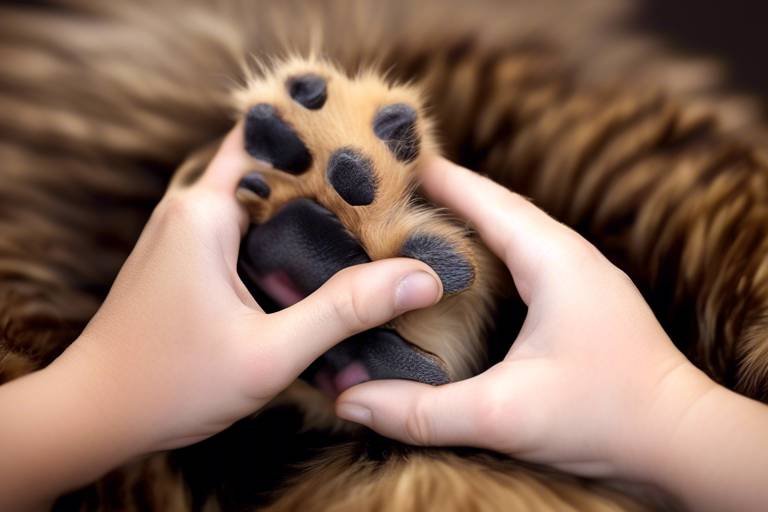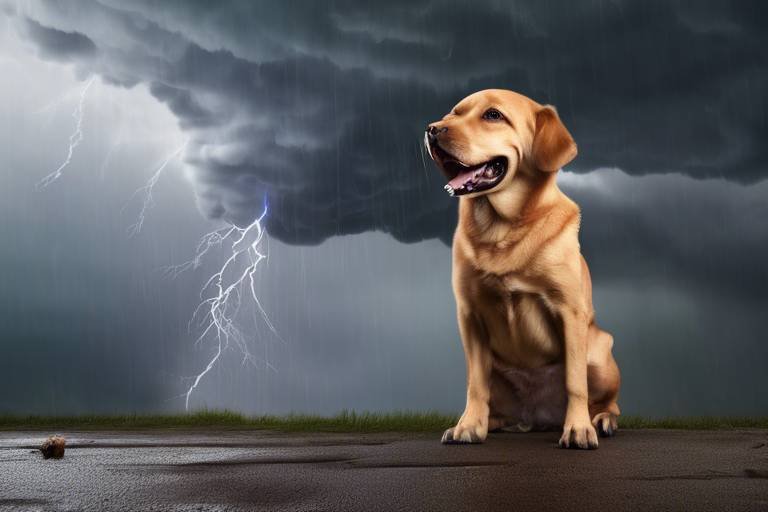How to Recognize and Treat Pet Hypothermia
As a loving pet owner, it's essential to be aware of the risks your furry friends face, especially when temperatures drop. Hypothermia is a serious condition that can affect pets just like it does humans, and knowing how to recognize and treat it can make a world of difference. Imagine your pet shivering uncontrollably, their energy sapped, and their usual playful demeanor replaced with lethargy. This is not just a chilling scenario; it could be a sign of hypothermia. In this article, we will explore the signs, symptoms, and treatments for hypothermia in pets, ensuring you can effectively recognize and respond to this potentially life-threatening condition.
So, what exactly is hypothermia? In simple terms, it occurs when a pet's body temperature drops significantly below the normal range, which is typically around 101 to 102.5 degrees Fahrenheit for dogs and cats. There are various causes of hypothermia, including prolonged exposure to cold weather, wet conditions, or even being left outside for too long during chilly nights. Pets that are very young, elderly, or have health issues are at a higher risk. Think of it like this: just as we bundle up in warm clothing to protect ourselves from the cold, our pets also need protection. But sometimes, they can't communicate their discomfort, leaving us to be their voice.
Recognizing the symptoms of hypothermia is crucial for timely treatment. If you notice your pet shivering, this is often the first sign that they are feeling cold. Shivering is the body's natural way of generating heat, much like how we might wrap ourselves in a blanket when we feel chilly. Other common signs include:
- Lethargy: Your pet may become unusually tired or less active.
- Difficulty Breathing: You might observe rapid or shallow breathing.
- Cold Extremities: Feel your pet's paws and ears; they may be noticeably cold to the touch.
When pets experience hypothermia, they may exhibit unusual behavior. You might notice a decline in their responsiveness or a change in their usual activity levels. It's like watching a light dim—where your once vibrant pet now seems to fade away. If your pet is less interested in playing or exploring, it could be an early warning sign. Always trust your instincts; if something feels off, it’s worth investigating further.
In addition to behavioral changes, physical symptoms like muscle stiffness and cold extremities can signal hypothermia. If your pet feels unusually stiff or their muscles seem tense, it's time to take action. This is your pet's body telling you that they are struggling to maintain warmth. Look for any signs of weakness, as this could indicate a more severe state of hypothermia.
In severe cases, pets may show critical symptoms such as unconsciousness or shallow breathing. This is a critical moment where immediate intervention is vital. If you find yourself in this situation, don’t hesitate; contact your veterinarian right away. The difference between a happy, wagging tail and a serious health crisis can often be a matter of minutes.
Various environmental factors can lead to hypothermia in pets. Cold weather is the most obvious culprit, but wet conditions can exacerbate the situation. Just think about how quickly we can feel cold when we’re wet; pets experience this too! Prolonged exposure to low temperatures, especially for pets that are not acclimated to such conditions, increases the risk significantly. Always monitor the weather and take necessary precautions to keep your furry companions safe.
If you suspect your pet is suffering from hypothermia, knowing how to provide first aid can save their life. The first step is to move your pet to a warm area immediately. Wrap them in blankets or towels to help retain heat. Acting quickly is essential, as every second counts when it comes to preventing further heat loss.
Once your pet is in a warm environment, it’s crucial to monitor their condition closely. You can use warm (not hot) water bottles or heating pads wrapped in towels to provide gentle warmth. However, be cautious; direct heat can cause burns, especially on sensitive skin. Think of it like giving your pet a warm hug, but one that’s gentle and safe.
When applying heat sources, ensure they are not too hot. Place your hand on the heat source first to gauge its temperature. The goal is to gradually warm your pet without causing additional stress or harm. Always keep an eye on your pet’s reaction; if they seem uncomfortable, adjust the heat source accordingly.
Seeking professional veterinary care is crucial for severe cases of hypothermia. During your visit, expect the veterinarian to perform various diagnostic procedures to assess the severity of the condition. This might include checking your pet's body temperature and conducting blood tests to evaluate their overall health.
Veterinarians may perform a range of diagnostic tests to determine how hypothermia has affected your pet's body. These tests are essential to understand the full extent of the situation and to create an effective treatment plan. They might check for signs of dehydration or organ dysfunction, which can occur in severe cases.
Treatment options for hypothermia can vary based on severity. In some cases, your pet might need intravenous fluids to help rehydrate and restore normal body temperature. Medications may also be administered to assist in managing any complications that arise from hypothermia. Just like humans, pets require a tailored approach to treatment, and your veterinarian will be the best guide in this process.
Q: Can hypothermia happen in warm climates?
A: Yes, hypothermia can occur in warm climates if pets are exposed to wet conditions or are left in air-conditioned environments for too long without adequate warmth.
Q: How can I prevent hypothermia in my pet?
A: Always provide shelter for your pets during cold weather, limit their time outdoors, and ensure they have warm bedding.
Q: What should I do if my pet shows signs of hypothermia?
A: Move them to a warm place, wrap them in blankets, and seek veterinary care immediately if their condition does not improve.

Understanding Hypothermia in Pets
Hypothermia is a serious condition that occurs when a pet's body temperature drops significantly below the normal range, which is typically between 101°F and 102.5°F for dogs and cats. When their body temperature falls below 99°F, they may begin to experience the detrimental effects of hypothermia. This condition can arise from various factors, including exposure to cold weather, wet environments, or prolonged periods of inactivity in low temperatures. Just like us, pets can suffer from the chill of winter, but they often lack the ability to communicate their discomfort effectively. It's crucial for pet owners to understand the causes and risk factors associated with hypothermia to ensure their furry friends remain safe and healthy.
There are several risk factors that can make pets more susceptible to hypothermia. For instance, small dog breeds, puppies, elderly pets, and those with pre-existing health conditions are at a higher risk. Additionally, pets that are wet, whether from rain or swimming, lose heat much faster than dry animals. Imagine stepping out of a warm shower into a cold room; that sudden chill is similar to what pets experience when they are wet and exposed to cold air. It’s essential to keep an eye on your pets during colder months, especially if they are outdoors for extended periods.
Different types of pets can be affected by hypothermia in various ways. For instance, while larger dog breeds may tolerate colder temperatures better than smaller breeds, they are not immune to the risks. Cats, on the other hand, often seek warmth in unusual places, which can lead them to dangerous situations if they cannot escape. Understanding how hypothermia affects your specific type of pet can help you take proactive measures to prevent it.
In summary, recognizing the signs and understanding the causes of hypothermia in pets is vital for every pet owner. By being aware of the risks and taking necessary precautions, you can ensure your furry companions stay warm and safe, especially during the colder months. Remember, prevention is always better than cure, so keep a watchful eye and create a cozy environment for your pets!

Signs and Symptoms of Hypothermia
Recognizing the signs and symptoms of hypothermia in pets is absolutely crucial for timely intervention. Just like humans, pets can suffer from dangerously low body temperatures, and being able to identify these symptoms can make all the difference. One of the first things you might notice is shivering. If your furry friend is trembling uncontrollably, it’s a clear indication that their body is trying to generate heat. However, shivering can sometimes be subtle, so don’t overlook other signs that may accompany it.
Another common symptom is lethargy. If your pet seems unusually tired or is reluctant to move, it could be a sign that they are feeling the effects of hypothermia. Think of it this way: when we feel cold and uncomfortable, we often want to curl up and do nothing. Your pet may exhibit the same behavior. Additionally, watch for signs of difficulty breathing. If your pet is panting or breathing more slowly than usual, this could indicate a serious drop in body temperature.
Behavioral changes can also serve as red flags. Pets experiencing hypothermia may become less responsive or even disoriented. Imagine your usually playful puppy suddenly turning into a sleepy, unresponsive lump. This can be alarming for any pet owner. If your pet is not reacting to your calls or seems to be in a daze, it’s time to take action. Furthermore, if you notice your pet seeking out warm places, such as curling up next to a heater or under blankets, it’s a strong indicator that they are feeling cold.
In addition to behavioral signs, physical symptoms are equally important to recognize. For instance, cold extremities—like paws and ears—can be a telltale sign of hypothermia. If you touch your pet’s paws and they feel icy, it’s a clear signal that their body temperature is dropping. Moreover, muscle stiffness can occur as the body struggles to maintain warmth. When you notice your pet moving stiffly or appearing to have difficulty walking, it’s time to take this seriously.
Now, let’s talk about severe cases. Unfortunately, in extreme situations, pets may exhibit critical symptoms such as unconsciousness or shallow breathing. These signs require immediate veterinary attention. If your pet is unresponsive or breathing very lightly, it’s essential to act fast. Remember, hypothermia can escalate quickly, and every second counts. Don’t hesitate to contact a vet if you observe these alarming symptoms.
Various environmental factors can lead to hypothermia in pets. Cold weather, particularly when combined with wet conditions, creates a dangerous situation. Prolonged exposure to low temperatures can overwhelm your pet’s ability to regulate their body heat. Think about how you feel when you’re caught in a chilly rain; it’s uncomfortable and can lead to health issues. Your pets are no different. Be mindful of the conditions they are exposed to, especially during winter months or in damp environments.
In summary, being vigilant about the signs and symptoms of hypothermia can save your pet’s life. Always keep an eye out for shivering, lethargy, difficulty breathing, and any unusual behavioral changes. Understanding these indicators is the first step in ensuring that your furry friend remains safe and healthy, especially during cold weather.
- What should I do if I suspect my pet has hypothermia? - Move them to a warm area and wrap them in blankets while seeking veterinary care.
- Can hypothermia occur in warm weather? - Yes, if a pet is wet and exposed to wind, they can experience hypothermia even in warmer temperatures.
- How can I prevent hypothermia in my pet? - Limit outdoor time in cold weather, provide warm bedding, and ensure they are dry and sheltered from the wind.
Behavioral Changes
When a pet is experiencing hypothermia, their behavior can change dramatically, often serving as the first indication that something is wrong. Just like how we might curl up under a blanket when we feel cold, pets exhibit similar signs of discomfort. You might notice them becoming less active than usual, as their body struggles to conserve energy in the face of chilling temperatures. This lethargy can be alarming, especially if your normally playful pup suddenly turns into a sleepyhead. It’s crucial to recognize this shift in behavior as it can be a significant warning sign.
Additionally, you may observe your pet becoming unusually withdrawn or less responsive to your calls. Imagine how you might feel when you're shivering and cold; you'd likely want to retreat into a cozy corner. Pets do the same, often seeking out warm spots or hiding away from the cold. It's essential to pay attention to these behavioral changes, as they can indicate that your furry friend is struggling to maintain their body temperature.
Another important behavioral change to look out for is agitation or restlessness. When pets are cold, they might pace or seem unable to settle down, much like a person who can’t get comfortable in a chilly room. This restlessness can be a signal that they are not only cold but are also feeling anxious or uncomfortable. If you observe these behaviors, it’s a clear call to action—your pet may need immediate warmth and comfort.
In severe cases, hypothermia can lead to confusion or disorientation. Just picture a time when you were so cold that you couldn’t think straight; pets can experience this too. If your pet seems lost or is having trouble with basic commands, it could be a sign that their body is struggling to cope with the cold. Recognizing these behavioral changes early on can be the difference between a quick recovery and a serious health crisis.
It's also important to note that different pets may exhibit different reactions to cold. For example, a small breed dog might show signs of hypothermia much quicker than a larger breed. Understanding your pet's typical behavior and personality can help you notice when something is off. Always keep an eye on your furry companions, especially during colder months, and be prepared to act if you notice these behavioral changes.
- What should I do if I suspect my pet has hypothermia?
Act quickly by moving them to a warm area and covering them with blankets. If symptoms persist, seek veterinary care. - How can I prevent hypothermia in my pet?
Limit outdoor time in cold weather, provide warm bedding, and consider pet clothing for smaller breeds or short-haired pets. - Are some pets more susceptible to hypothermia than others?
Yes, smaller breeds, older pets, and those with health issues are more vulnerable to cold temperatures.
Physical Symptoms
When it comes to recognizing hypothermia in pets, paying attention to is just as important as noting behavioral changes. A pet suffering from hypothermia may exhibit a variety of alarming physical signs that can alert you to the severity of their condition. One of the first things you might notice is their extremities feeling cold to the touch. This includes their paws, ears, and tail, which can all become noticeably chilly as their body temperature drops.
Another common physical symptom is muscle stiffness. As the body struggles to maintain warmth, muscles may become rigid and tense, making it difficult for your pet to move comfortably. This can lead to a noticeable reduction in their activity levels, as they may seem reluctant to engage in play or even walk around. Additionally, you may observe that their body posture changes; they might hunch down or curl up tightly in an attempt to conserve heat.
In more severe cases of hypothermia, you might find that your pet's breathing becomes shallow or irregular. This is a critical sign that immediate intervention is necessary. The body is working hard to cope with the cold, and as a result, you may notice a significant decrease in their overall responsiveness. If your pet appears to be lethargic or unresponsive, it’s crucial to act quickly.
To summarize, here are some key physical symptoms to watch for:
- Cold extremities (paws, ears, tail)
- Muscle stiffness
- Shallow or irregular breathing
- Lethargy or unresponsiveness
Recognizing these symptoms early can be a lifesaver. If you notice any of these signs in your pet, it’s essential to take action immediately and seek veterinary assistance. Remember, the sooner you respond, the better the chances are for a positive outcome!
Q: How can I prevent hypothermia in my pet?
A: Keeping your pet indoors during cold weather, providing warm bedding, and ensuring they are dry after being outside can help prevent hypothermia.
Q: What should I do if I suspect my pet has hypothermia?
A: Move your pet to a warm area, wrap them in blankets, and seek veterinary care immediately if symptoms are severe.
Q: Can all pets get hypothermia?
A: Yes, while some breeds are more susceptible due to their size or coat type, any pet can experience hypothermia if exposed to extreme cold.
Q: How quickly can hypothermia set in?
A: Hypothermia can develop rapidly, especially in small or short-haired pets exposed to cold, wet conditions.
Severe Cases
When it comes to hypothermia in pets, recognizing the signs of severe cases can mean the difference between life and death. In these critical situations, your furry friend may exhibit alarming symptoms that require immediate action. For instance, if your pet becomes unconscious or shows signs of shallow breathing, it’s crucial to seek veterinary help without delay. These symptoms indicate that the body is struggling to maintain its core temperature, and time is of the essence.
In severe cases, pets may also display other troubling signs such as:
- Weakness: A noticeable lack of energy or inability to stand can be a major red flag.
- Cold to the touch: If your pet’s body feels cold, especially around the extremities, it’s a sign that their body is losing heat rapidly.
- Slow heart rate: Hypothermia can lead to bradycardia, where the heart rate drops significantly.
These symptoms can escalate quickly, leading to organ failure if not addressed promptly. The body’s metabolic processes slow down, and vital organs like the heart and brain begin to suffer from lack of adequate blood flow and oxygen. Imagine your pet’s body as a car engine that’s running too cold; it can’t function properly, and if left unattended, it could lead to a complete breakdown.
It’s also important to note that some pets are more susceptible to severe hypothermia than others. Small breeds, young puppies, and senior pets are particularly at risk due to their smaller body mass and less insulating fat. If you suspect your pet is in a severe state of hypothermia, don’t hesitate to act. Wrap them in warm blankets, avoid using hot water directly on their skin, and get them to a veterinary clinic as soon as possible. Remember, in these situations, every second counts!
- What should I do if I suspect my pet has hypothermia?
Immediately move your pet to a warm environment, cover them with blankets, and contact your veterinarian. - Can hypothermia be treated at home?
While mild hypothermia can be managed at home, severe cases require professional veterinary care. - How can I prevent hypothermia in my pet?
Limit your pet's exposure to cold weather, provide adequate shelter, and ensure they have a warm place to rest.
Environmental Factors Contributing to Hypothermia
When it comes to hypothermia in pets, the environment plays a significant role. Just like humans, our furry friends can be affected by temperature extremes, and certain conditions can exacerbate the risk of their body temperature dropping to dangerous levels. Understanding these environmental factors is crucial for pet owners who want to keep their pets safe and healthy.
Cold weather is the most obvious culprit. During winter months, temperatures can plummet, especially during nighttime or in windy conditions. Pets that are left outside for extended periods may not be able to regulate their body temperature effectively, leading to hypothermia. Additionally, wet conditions can dramatically increase the risk. When a pet's fur becomes wet, it loses its insulating properties, making it easier for the cold to seep in. This is particularly true for breeds with shorter coats or those that are not acclimated to cold weather.
Another factor to consider is the age and health of your pet. Young puppies and elderly pets are particularly vulnerable to hypothermia. Their bodies may not respond as efficiently to temperature changes, and they can easily become chilled. Likewise, pets with certain health conditions, such as diabetes or hormonal imbalances, may also struggle to maintain their core temperature in cold environments.
It's also worth noting that prolonged exposure to low temperatures can lead to hypothermia even in seemingly healthy pets. For instance, a dog playing in the snow may enjoy the fun initially, but after a while, the cold can take its toll. Pet owners should always be vigilant and watch for signs of discomfort or lethargy, as these can be early indicators of a drop in body temperature.
In summary, several environmental factors contribute to hypothermia in pets, including:
- Cold Weather: Extreme temperatures, especially during winter.
- Wet Conditions: Rain or snow can soak a pet's fur, losing insulation.
- Age: Young and elderly pets are more susceptible.
- Health Conditions: Certain medical issues can impair temperature regulation.
- Prolonged Exposure: Extended time in cold can lead to hypothermia, even in healthy pets.

First Aid for Hypothermia
When it comes to your furry friend, knowing how to provide can be a matter of life and death. Hypothermia can sneak up on pets, especially during those chilly winter months or in unexpected wet weather. If you suspect that your pet is suffering from hypothermia, it’s crucial to act quickly and efficiently. The first step is to move your pet to a warm, dry area. This could be indoors or even a sheltered spot that is out of the wind. The goal is to get them away from the cold as soon as possible.
Once you’ve relocated your pet, wrap them in warm blankets or towels. It’s like giving them a big, cozy hug! Make sure to cover their entire body, but be cautious around their face to avoid overheating. If they are particularly small or have short fur, you might want to consider using a heating pad on a low setting or a warm water bottle wrapped in a towel. However, be careful not to apply direct heat, as this can cause burns on their sensitive skin. Remember, the idea is to gently warm them up, not to roast them!
In addition to using blankets and heat sources, you can also offer your pet some warm, non-alcoholic fluids if they are conscious and alert. Think of it as a nice hot drink to help them feel better! Warm chicken broth or a little bit of water can help rehydrate them and provide some warmth from the inside out. However, if your pet is lethargic or unresponsive, do not try to force them to drink.
It’s essential to monitor your pet’s condition closely. Look for signs of improvement, such as increased alertness or a return to normal body temperature. If your pet does not show any signs of recovery within a reasonable amount of time, or if their condition seems to worsen, it’s time to seek veterinary care. Don’t hesitate to contact your vet or an emergency animal clinic. They have the tools and expertise to properly assess and treat hypothermia.
Here’s a quick overview of the immediate actions to take:
- Move your pet to a warm, dry area.
- Wrap them in warm blankets or towels.
- Use a heating pad or warm water bottle, avoiding direct contact with the skin.
- Offer warm fluids if they are alert.
- Monitor their condition and seek veterinary help if necessary.
Remember, being prepared and knowing how to respond can make all the difference. Just like you would want someone to help you in a time of need, your pet relies on you to be their advocate and protector. So, keep these tips in mind for those cold days, and you'll be ready to spring into action if your furry friend ever needs you!
Here are some common questions pet owners have regarding hypothermia:
| Question | Answer |
|---|---|
| What are the first signs of hypothermia in pets? | Signs include shivering, lethargy, and difficulty breathing. |
| Can I use a hairdryer to warm my pet? | No, using a hairdryer can cause burns. Stick to blankets and warm water bottles. |
| How long does it take for a pet to recover from hypothermia? | Recovery time varies, but if there’s no improvement within 30 minutes, seek veterinary care. |
Immediate Actions
When you suspect that your pet is suffering from hypothermia, immediate action can be the difference between life and death. First and foremost, it's essential to act quickly—time is of the essence. Start by gently moving your pet to a warm, dry area away from the cold. This could be inside your home or a heated garage. The goal is to minimize further exposure to low temperatures. Once you've relocated your furry friend, wrap them in warm blankets or towels to help retain body heat. It’s like giving them a cozy hug that can make all the difference!
As you tend to your pet, monitor their body temperature if possible. A normal temperature for dogs and cats ranges between 100.5°F and 102.5°F (38°C to 39.2°C). If you have a pet thermometer, it can be a handy tool to gauge their condition. If their temperature is significantly below this range, it’s a clear indication that you need to act fast.
Additionally, while you are providing warmth, be cautious about using heat sources. You can use heating pads or warm water bottles, but make sure to wrap them in a towel to avoid direct contact with your pet's skin. This is crucial because overheating can lead to burns or shock. Always check the temperature of the heat source before applying it to your pet. You want to warm them up gradually, not create a sudden temperature shock!
Another important step is to offer your pet warm fluids if they are alert and able to drink. Warm broth or water can help rehydrate them and provide some internal warmth. However, avoid giving them anything too hot—think of it like serving soup; you wouldn’t want it to burn your tongue! If your pet is unresponsive or unable to drink, do not force it; instead, focus on keeping them warm until you can get them to a veterinarian.
In the midst of all this, don’t forget to keep an eye on their breathing and heart rate. If you notice any signs of distress, such as shallow breathing or a weak pulse, it’s crucial to seek veterinary care immediately. Remember, you are their advocate, and your quick actions can save their life!
Using Heat Sources Safely
When your furry friend is suffering from hypothermia, it’s essential to act swiftly and wisely, especially when it comes to using heat sources. You want to warm them up, but doing it the wrong way can lead to serious burns or shock. Think of it like warming a frozen pizza in the oven – if you crank the heat too high, you’ll end up with a charred crust instead of a delicious meal. The same principle applies to your pet. Here are some safe methods to rewarm them:
First, always start by moving your pet to a warmer environment. This can be a heated room or a cozy spot away from drafts. Once they’re in a safe zone, you can introduce heat sources gradually. One effective method is using heating pads or warm water bottles. However, you need to ensure that these items are not too hot. A good rule of thumb is to place a towel between the heat source and your pet’s body. This barrier helps prevent direct contact, which can cause burns. Remember, pets can’t tell you when something is too hot, so it’s up to you to be their advocate.
Another great option is to use blankets. Wrap your pet snugly in a warm blanket, but be careful not to restrict their movement. You want to create a warm cocoon without making them feel trapped. You can also use your own body heat! Cuddling up with your pet can provide them with the warmth they desperately need. It’s a win-win situation, as you’ll both feel the comfort of each other’s warmth.
Here’s a quick table summarizing safe heat sources:
| Heat Source | Safety Tips |
|---|---|
| Heating Pad | Use on low setting, place a towel in between. |
| Warm Water Bottle | Wrap in a towel, check temperature regularly. |
| Blankets | Wrap snugly but allow for movement. |
| Your Body Heat | Cuddle with your pet for warmth. |
While these methods are effective, it’s crucial to monitor your pet closely. Keep an eye on their behavior and body temperature. If they start to show signs of discomfort or if their condition doesn’t improve, it’s time to seek veterinary assistance. Remember, the goal is to gradually raise their body temperature to a safe level without causing any additional harm.
In summary, using heat sources safely involves a combination of common sense and careful monitoring. By taking the right precautions, you can help your pet recover from hypothermia while ensuring their comfort and safety. Just like you would take care of a delicate flower, nurturing your pet back to health requires patience and gentleness.
- How can I tell if my pet is too cold? Look for signs like shivering, lethargy, and cold extremities. If they seem unusually quiet or are seeking warmth, they may be feeling the chill.
- Can I use a hairdryer to warm my pet? It’s not recommended. The heat can be too intense and may cause burns. Stick to safer methods like heating pads or blankets.
- How long should I keep my pet warm? Monitor your pet’s temperature and behavior. Generally, warming them gradually over 20-30 minutes is ideal, but always check for signs of improvement.

Veterinary Care and Treatment
When it comes to severe cases of hypothermia, seeking professional veterinary care is not just a recommendation; it's a necessity. The sooner you can get your pet to a vet, the better their chances of recovery. At the veterinary clinic, the first step often involves a thorough examination to assess the severity of the hypothermia. This examination may include measuring the pet's body temperature using a rectal thermometer, as this is the most accurate method. The vet will also check for any other signs of distress or underlying health issues that may have contributed to the hypothermia.
During your visit, you can expect several diagnostic procedures to be performed. These may include:
- Blood tests: To evaluate organ function and check for any abnormalities.
- X-rays: To rule out any injuries or conditions that might be causing the hypothermia.
- Urinalysis: To assess hydration levels and kidney function.
Each of these tests plays a crucial role in understanding your pet's condition and determining the best course of action. Once the vet has gathered enough information, they will discuss treatment options tailored to your pet’s specific needs. Treatment can vary widely depending on the severity of the hypothermia. In mild cases, warming your pet gradually may suffice, but in more severe situations, the vet may recommend:
| Treatment Option | Description |
|---|---|
| Intravenous Fluids | Administering warmed fluids can help rehydrate and gradually increase body temperature. |
| Oxygen Therapy | For pets showing signs of respiratory distress, oxygen therapy may be necessary. |
| Medications | Depending on the underlying causes, medications may be prescribed to treat any concurrent issues. |
It's important to follow the veterinarian's instructions closely, as improper treatment can lead to further complications. After treatment, your pet may need to stay at the clinic for observation, especially if they were severely hypothermic. This allows the veterinary team to monitor their recovery and ensure that their body temperature stabilizes at a safe level.
In addition to the immediate care provided, your vet may also offer guidance on how to prevent future incidents of hypothermia. This could include recommendations for appropriate clothing for your pets during cold weather or tips on how to create a safe and warm environment for them at home.
Ultimately, understanding the signs of hypothermia and knowing when to seek veterinary care can make all the difference in your pet's recovery. Remember, your furry friends rely on you to keep them safe and healthy, so being informed is key!
Q: How can I tell if my pet is at risk for hypothermia?
A: Pets at risk for hypothermia include those with short fur, very young or old pets, and those with health issues. Always monitor them during cold weather.
Q: What should I do if my pet shows signs of hypothermia?
A: Act quickly! Move them to a warm place, wrap them in blankets, and contact your veterinarian immediately.
Q: Can hypothermia be fatal?
A: Yes, severe hypothermia can be life-threatening. Prompt veterinary care is essential for recovery.
Diagnostic Procedures
When a pet is suspected of having hypothermia, the first step is usually a visit to the veterinarian, who will conduct a thorough examination. This examination often begins with a physical assessment, where the vet will check the pet's overall condition, including its temperature, heart rate, and respiratory rate. A normal body temperature for most pets typically ranges between 100.5°F to 102.5°F (38.1°C to 39.2°C). If the temperature falls below this range, it raises immediate concerns about hypothermia.
In addition to the physical assessment, veterinarians may perform a series of diagnostic tests to evaluate the severity of the condition. These tests can include:
- Blood tests: These can help determine if there are any underlying health issues or infections that could complicate the hypothermia.
- X-rays: If there is a suspicion of trauma or other complications, X-rays may be taken to rule out any injuries.
- Electrolyte panels: These tests assess the balance of minerals in the pet’s body, which can be disrupted by hypothermia.
Each of these diagnostic procedures is crucial for developing an appropriate treatment plan. For instance, if blood tests reveal an infection, the vet may need to administer antibiotics alongside treatments for hypothermia. The results of these tests will inform the veterinary team about the best course of action, whether it involves warming techniques, intravenous fluids, or other medical interventions.
It's important to remember that time is of the essence when dealing with hypothermia. The sooner a veterinarian can assess and diagnose the condition, the better the chances of a full recovery for your furry friend. So, if you suspect your pet is suffering from hypothermia, don’t hesitate—seek veterinary care immediately!
Q1: How do I know if my pet is hypothermic?
A: Look for signs such as shivering, lethargy, cold extremities, and difficulty breathing. If your pet's body temperature is below normal, seek veterinary assistance.
Q2: Can hypothermia be fatal for pets?
A: Yes, severe hypothermia can be life-threatening. Prompt treatment is essential to prevent serious complications or death.
Q3: What should I do if I suspect my pet has hypothermia?
A: Move your pet to a warm area, wrap them in blankets, and contact your veterinarian immediately for further instructions.
Q4: How can I prevent hypothermia in my pet?
A: Ensure your pet has a warm, dry place to stay during cold weather, limit their exposure to low temperatures, and consider using pet clothing for extra warmth.
Treatment Options
When it comes to treating hypothermia in pets, the approach can vary significantly based on the severity of the condition. Understanding the available treatment options is vital for pet owners, as timely intervention can mean the difference between life and death. In mild cases, simply warming your pet in a cozy environment and providing blankets may suffice. However, in more severe situations, veterinary intervention becomes crucial.
Veterinarians typically assess the severity of hypothermia through a series of diagnostic procedures, which may include:
- Physical examination to check for cold extremities and overall body temperature.
- Blood tests to evaluate organ function and detect any underlying issues.
- X-rays or ultrasounds to assess for any complications.
Once the diagnosis is confirmed, treatment options can be tailored to the pet's specific needs. Common treatment interventions include:
- Intravenous (IV) Fluids: Administering warmed IV fluids helps to rehydrate and restore normal body temperature more effectively.
- Medications: Depending on the situation, medications may be prescribed to stimulate circulation or address any underlying health issues that may have contributed to the hypothermia.
- Warming Techniques: This may involve using specialized warming blankets or heating pads that provide controlled warmth. It's essential to monitor the pet closely to avoid overheating.
- Oxygen Therapy: In cases where breathing is shallow or labored, oxygen therapy can help ensure that the pet receives adequate oxygen while their body temperature stabilizes.
It’s important to note that treatment should always be overseen by a veterinarian, as improper warming techniques can lead to complications such as shock or burns. As a loving pet owner, your goal is to provide a safe and effective recovery environment for your furry friend.
Q: How can I tell if my pet is hypothermic?
A: Look for signs such as shivering, lethargy, cold extremities, and difficulty breathing. If you notice these symptoms, it's crucial to act quickly.
Q: Can I treat mild hypothermia at home?
A: Yes, for mild cases, you can gently warm your pet with blankets and move them to a warmer area. However, if symptoms persist or worsen, seek veterinary care immediately.
Q: What should I avoid when treating hypothermia?
A: Avoid using direct heat sources like hair dryers or heating lamps, as they can cause burns. Instead, use warm blankets or heat pads that provide gradual warmth.
Q: How long does it take for a pet to recover from hypothermia?
A: Recovery time can vary depending on the severity of the hypothermia and the treatment provided. Mild cases may recover within hours, while severe cases may take longer and require veterinary care.
Frequently Asked Questions
- What is hypothermia in pets?
Hypothermia in pets occurs when their body temperature drops significantly, usually below the normal range of 100 to 102.5 degrees Fahrenheit. It can be life-threatening if not addressed promptly, and it often results from prolonged exposure to cold weather or wet conditions.
- What are the common signs of hypothermia in dogs and cats?
Common signs of hypothermia include shivering, lethargy, weakness, and difficulty breathing. You may also notice behavioral changes, such as decreased responsiveness or unusual activity levels. In severe cases, pets might become unconscious or exhibit shallow breathing.
- How can I provide first aid to a pet suspected of hypothermia?
If you suspect your pet has hypothermia, the first step is to move them to a warm area. Cover them with blankets to retain heat. You can also use heat sources like heating pads or warm water bottles, but make sure they are not too hot to prevent burns.
- When should I seek veterinary care for my pet's hypothermia?
You should seek veterinary care immediately if your pet shows severe symptoms, such as unconsciousness, shallow breathing, or if their condition does not improve with first aid measures. A veterinarian can provide essential treatments to stabilize your pet.
- What treatments can a veterinarian provide for hypothermia?
Veterinarians may perform diagnostic tests to assess the severity of hypothermia and provide treatments such as intravenous fluids, medications, and controlled warming techniques to help restore your pet's normal body temperature.
- Can all pets experience hypothermia?
Yes, all pets can experience hypothermia, but some may be more vulnerable than others. Small breeds, elderly pets, and those with health issues are at a higher risk, especially in cold or wet environments.
- How can I prevent hypothermia in my pets?
To prevent hypothermia, ensure your pets have a warm, dry place to stay during cold weather. Limit their exposure to low temperatures, provide warm bedding, and consider using pet clothing such as jackets or sweaters for added protection.



















